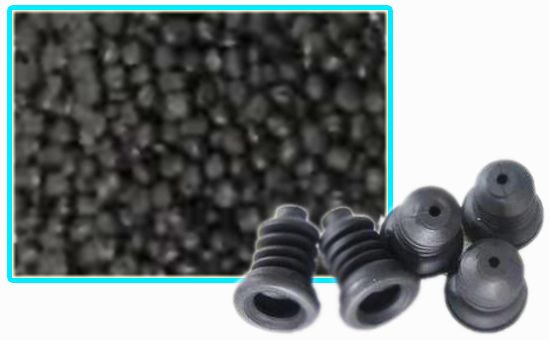
As a product of waste butyl rubber products, butyl reclaimed rubber can be used not only to replace butyl rubber to produce various high-airtight rubber products, shock absorbing products, corrosion-resistant products, but also to replace butyl rubber and poly. When propylene is used together to prepare TPV, what is called TPV, and what is the performance advantage of using TPV prepared by using butyl reclaimed rubber and PP? What problems should be paid attention to during the preparation process?
1. Introduction to TPV
TPV is thermoplastic vulcanized rubber, English is Thermoplastic Vulcanizate, polypropylene alloy thermoplastic elastomer, mainly composed of two parts: plastic (as continuous phase) + rubber (as dispersed phase), through softener, plasticizer, vulcanizing agent and other coordination The new rubber and plastic materials with small specific gravity, good hand elasticity, compression resistance and aging resistance can reduce production cost and recycle, and are widely used in auto parts, daily necessities, electronic devices, transportation equipment, Building materials and other fields.
2. Advantages of preparing TPV from butyl reclaimed rubber and polypropylene
Studies have shown that butyl rubber / polypropylene thermoplastic elastomer barrier properties (material barrier properties refers to a certain thickness of the product under a certain pressure, a certain temperature, a certain humidity, the volume of small molecules per unit area per unit area Or weight) excellent, but the price of butyl rubber is higher in actual production; butyl reclaimed rubber made from waste butyl rubber products is airtight, watertight, heat resistant, aging resistant, corrosion resistant, and replaced The preparation of TPV from butyl rubber not only maintains the physical properties, but also significantly reduces the cost of raw materials.
3. Preparation of TPV basic formula from butyl reclaimed rubber and polypropylene
Butyl reclaimed rubber, 60 parts; polypropylene, 40 parts; carbon black N330, 30 parts; stearic acid, 1 part; paraffin, 3 parts; zinc oxide, 5 parts; vulcanizing agent brominated phenolic resin (SP-1055) , 6 parts; stannous chloride, 3 parts; total: 148 parts.
4. butyl regenerated rubber and polypropylene preparation TPV process
When butyl regenerated rubber/PP is used to prepare TPV, if the accelerator is added in the dynamic desulfurization process, it is easy to cause uneven dispersion of the accelerator, excessive local concentration, and too fast crosslinking rate in the initial stage of blending, resulting in vulcanization of vulcanizate. The problem of uneven degree and poor TPV performance; therefore, it is necessary to uniformly disperse the promoter in the masterbatch before dynamic desulfurization. In the dynamic desulfurization, the plastic phase can uniformly transfer the stress under the action of shearing force. The base reclaimed rubber particles are uniformly dispersed and fully crosslinked, the degree of vulcanization is severe, the rubber phase is sufficiently crosslinked, the refining and dispersing effect is good, the rubber phase and the plastic phase have better compatibility, and the prepared TPV has better comprehensive performance.
TPV elastomer prepared by using butyl reclaimed rubber and polypropylene together has low preparation cost and good barrier property, and can be widely used in various industries. Xiaobian also wants to say another sentence: the quality of butyl reclaimed rubber on the market is uneven, certain To polish your eyes, put a good butyl reclaimed rubber and a good reclaimed rubber factory.
Exclusive original article [commercial authorization] reprint, excerpt and excerpt in any form are prohibited without written authorization. Focus on Hongyun rubber: learn the process formula and raw material technology of producing rubber products from recycled rubber to help you reduce costs and increase profits